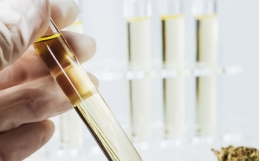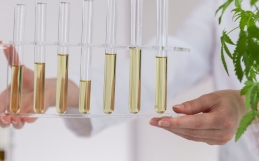According to Medical Jane, a research-oriented site that aims at educating medical patients on the use of cannabis, the cannabinoid CBG is thought to counteract some of the not-so-desirable effects of THC. Think the “paranoid” or anxious high that can sometimes come with strains of cannabis high in THC (Dorm, 2013).
Typically what someone will find with “street” marijuana is a more potent THC strain that delivers a more noticeable high, but for the medical marijuana patient, a high THC strain isn’t always practical or desirable. That’s where learning about strains and the benefits of other lesser known cannabinoids can be of great benefit during treatment.

Young cannabis plants, marijuana, close-up.
One other effect of CBG is that it may decrease anxiety as well as muscle tension due to inhibiting GABA. This effect is similar to the cannabinoid CBD. For this reason, strains that are high in CBG may be desirable for those who have muscular issues or pain such as fibromyalgia.
In a report published in the British Journal of Pharmacology (Russo, 2010), studies also suggest that CBG is effective in a range of treatment and therapies including:
- Producing modest antifungal effects
- Inhibiting keratinocyte proliferation — may be useful in treatment of psoriasis
- In conjunction with l-limonene (citrus terpene found in cannabis), CBG shows promising results to fight breast cancer
- Pure CBG and CBD cannabinoids can powerfully inhibit MRSA
Whether incorporated in your therapy via medical marijuana or used in oil, CBG offers huge benefit to a patient who is fighting a wide range of illnesses.
By using the MyDx Analyzer with the CannaDx Sensor, you can better pinpoint the cannabis strains that are ideal for you. Find treatment that works to alleviate your symptoms and provide the best benefits.
Find out more about why this sensor can be invaluable in your therapy: https://www.mydxlife.com/canna-sensor/
References
Dorm, D. (2013, August 3). What is Cannabigerol (CBG)? Retrieved from Medical Jane: http://www.medicaljane.com/2013/08/03/cannabigerol-cbg-is-a-minor-cannabinoid-with-major-impact/
Russo, E. (2010). Taming THC: potential cannabis synergy and phytocannabinoid-terpenoid entourage effects. British Journal of Pharmacology, 1348.







